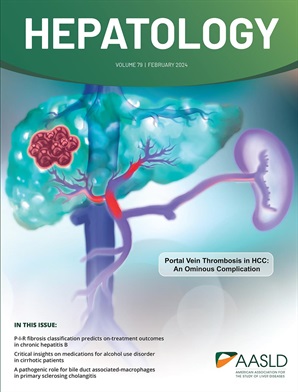靶向甾醇o -酰基转移酶1重组脂肪酸代谢,揭示肝细胞癌的免疫脆弱性。
IF 15.8
1区 医学
Q1 GASTROENTEROLOGY & HEPATOLOGY
引用次数: 0
摘要
背景和目的肝细胞癌(HCC)的发展与代谢过程和免疫逃避策略有着复杂的联系。甾醇o -酰基转移酶1 (SOAT1)作为HCC中一种新兴的代谢易感物,其具体的分子机制及其在免疫调节中的作用尚不清楚。本研究旨在阐明SOAT1的相关机制,并评估其作为治疗靶点的潜力。方法和结果我们在细胞系、患者来源的类器官和小鼠模型中通过遗传和药物抑制探索了SOAT1的作用。共培养系统、流式细胞术和免疫组织化学被用来评估肿瘤-免疫相互作用。通过多组学研究来阐明潜在的分子机制。在体内测试了单独抑制SOAT1和联合抗pd1治疗的疗效。SOAT1在HCC肿瘤中显著上调,并与增加的致瘤性和免疫逃避特性相关。SOAT1缺乏破坏脂质稳态,导致饱和脂肪酸、活性氧积累和内质网应激,随后是NF-κB活化。该信号触发了促炎细胞因子、粘附分子的产生,并将CD11c +抗原呈递细胞和细胞毒性CD8 + T细胞募集到肿瘤中。此外,SOAT1敲除可减轻肿瘤负荷,SOAT1抑制与PD-1阻断联合抗肿瘤具有协同作用。结论soat1在HCC中既具有代谢易感性,又具有免疫调节作用。它的抑制作用破坏肿瘤促进代谢过程,同时增强免疫激活,使其成为一个有希望的治疗靶点。SOAT1抑制联合PD-1阻断有望改善HCC免疫治疗的结果。本文章由计算机程序翻译,如有差异,请以英文原文为准。
Targeting sterol O-acyltransferase 1 rewires fatty acid metabolism and uncovers immune vulnerability in hepatocellular carcinoma.
BACKGROUND AND AIMS
The development of hepatocellular carcinoma (HCC) is intricately linked to metabolic processes and immune evasion strategies. As an emerging metabolic vulnerability in HCC, detailed molecular mechanisms of Sterol O-Acyltransferase 1 (SOAT1) and its role in immune regulation remain unclear. This study aimed to elucidate the mechanism involved and evaluate the potential of SOAT1 as a therapeutic target.
APPROACH AND RESULTS
We explored the role of SOAT1 using genetical and pharmaceutical inhibition in cell lines, patient-derived organoids, and mouse models. Co-culture systems, flow cytometry, and immunohistochemistry were employed to assess tumor-immune interactions. Multi-omics were performed to elucidate the underlying molecular mechanisms. The efficacy of inhibiting SOAT1 alone and in combination with anti-PD1 therapy in vivo was tested. SOAT1 was significantly upregulated in HCC tumors and associated with increased tumorigenicity and immune evasive characteristics. SOAT1 deficiency disrupted lipid homeostasis, leading to the accumulation of saturated fatty acids, reactive oxygen species, and endoplasmic reticulum stress, followed by NF-κB activation. This signaling triggered the production of pro-inflammatory cytokines, adhesion molecules, and the recruitment of CD11c⁺ antigen-presenting cells and cytotoxic CD8⁺ T cells into tumors. Moreover, SOAT1 knockout reduced tumor burden, and the combination of SOAT1 inhibition with PD-1 blockade exhibited synergistic anti-tumor effects.
CONCLUSION
SOAT1 functions as both a metabolic vulnerability and an immune regulator in HCC. Its inhibition disrupts tumor-promoting metabolic processes while enhancing immune activation, presenting it as a promising therapeutic target. Combining SOAT1 inhibition with PD-1 blockade holds potential for improving outcomes in HCC immunotherapy.
求助全文
通过发布文献求助,成功后即可免费获取论文全文。
去求助
来源期刊

Hepatology
医学-胃肠肝病学
CiteScore
27.50
自引率
3.70%
发文量
609
审稿时长
1 months
期刊介绍:
HEPATOLOGY is recognized as the leading publication in the field of liver disease. It features original, peer-reviewed articles covering various aspects of liver structure, function, and disease. The journal's distinguished Editorial Board carefully selects the best articles each month, focusing on topics including immunology, chronic hepatitis, viral hepatitis, cirrhosis, genetic and metabolic liver diseases, liver cancer, and drug metabolism.
 求助内容:
求助内容: 应助结果提醒方式:
应助结果提醒方式:


